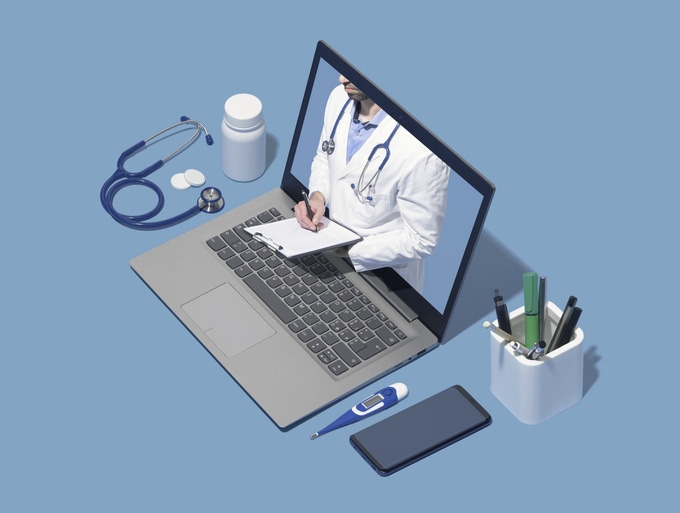Expanded remote patient monitoring is needed to amplify telehealth benefits.
July 30, 2020

Key takeaways from this article include the following:
Telehealth benefits are evident during a pandemic, but the explosion of health-related consumer devices in the past decade has yet to fuel widespread use in clinically actionable data.
Cash-strapped hospitals need to find innovative ways of expanding remote patient monitoring infrastructure.
Future telehealth growth depends on having a robust data infrastructure that can contextualize data streams while also protecting patient privacy.
While telehealth has seen unprecedented growth in the first half of 2020, its continued popularity will depend in part on the availability of expanded remote patient monitoring capabilities. Even though scores of internet-connected health and medical devices have been developed, they frequently haven’t been incorporated into routine clinical care.
“The ability to integrate [remote health data] is really limited,” said Michael Blum, executive director at the Center for Digital Health Innovation at the University of California, San Francisco, in a webinar. Consequently, many physicians have struggled to treat patients remotely as they lack vital sign data that is routine for in-person exams, said Blum, a cardiologist. Despite the availability of devices that can remotely monitor everything from pulse, electrocardiograms, blood pressure, pulse oxygenation and beyond from a patient’s home, many physicians lack the infrastructure to use data from such devices clinically. “The technology out there is fantastic, but the reality is I am [still trying] to figure out how to make those first baby steps in using these devices in the clinic,” Blum said.
[IoT World, North America’s largest IoT event, is going virtual August 11–13 with a three-day virtual experience putting IoT, AI, 5G and edge into action across industry verticals. Register today.]
While many patients are familiar with such Internet of Things (IoT) technologies, many hospitals struggled to figure out a financial model for them, according to Daniel Elizalde, head of Ericsson’s North American Internet of Things division.
Financial challenges and data hurdles are two reasons that the transition to data-driven patient-centered health care has been relatively slow, according to Bill Betten, president of Betten Systems Solutions. In the patient-centered model, health care decisions and quality measurements are based on an “individual’s specific health needs and desired health outcomes,” as explained in the New England Journal of Medicine. One of the chief barriers for patient-centric care is data silos. But in a patient-centric model, data can be integrated from various sources to enhance patient outcomes. “If I am sick, I want doctors to have access to every relevant piece of information they can get,” Betten said.
Another hurdle in the U.S. has been the lack of reimbursement for telehealth and remote patient monitoring, said Carrie Nixon, managing partner of the Nixon Law Group. Before the COVID-19 outbreak, federal law required patients to be in rural or underserved areas to be eligible for telehealth. “Once we’re out of the public health emergency, we could go right back to where we were with basically no reimbursement for telehealth,” Nixon said.
The possibility that reimbursement for telehealth could fall in the future has had a chilling effect for some health care providers. “Some smaller and less progressive practices in the U.S. are still not willing to fully implement a telehealth program when they’re just not sure whether reimbursement will be sustained in the long term,” Nixon said.
Few regions in the world have substantial experience with remote patient care. Before the COVID-19 outbreak, telehealth in Europe had been rarely used for remote patient care. Instead, the main focus of the technology was for “administrative meetings, training, and staff education,” according to the “HIMSS e-Health Trendbarometer: Telehealth Adoption in Europe.” In Asia, only 22% of consumers had used telemedicine services before COVID-19 spread across the region, according to Bain & Company. Internationally, the average share of health care visits administered remotely before the pandemic was 16%, according to a survey from the physician platform Sermo.
While the share of remote visits internationally hit 57% in April, according to data from Sermo, physicians expect the number to fall to approximately 25% of visits when the crisis subsides. U.S. telehealth has begun to taper off after peaking in April, according to data from STAT and the Commonwealth Fund.
While telemedicine is likely to see steady growth in a post-COVID-19 world, convincing hospitals now to invest in relevant technology has only grown more precarious in recent months. The American Hospital Association estimates that U.S. hospitals stand to lose $323 billion this year as a result of the novel coronavirus. Small physician practices have also fared poorly. “No one has money right now to spend on new [telehealth] solutions,” Blum said.
In theory, aggregating data to fuel analytics for symptom monitoring and population health management would likely be fairly straightforward. But the fragmented nature of health care in the United States could be an obstacle limiting telehealth benefits. Consumer-facing wearable devices can offer relevant patient data to physicians, but data quality issues, liability risks, interoperability and cybersecurity are common obstacles. Meanwhile, most patients have limited capacity to interpret health data on their own. A standardized approach is needed to overcome such hurdles. “It may be easier in places like the United Kingdom where you have nationalized health care,” said Massimo Russo, a managing director and senior partner at the Boston Consulting Group.
Private enterprise could play a vital role in collecting and standardizing remote patient data in the U.S., Blum said. “We are looking for partners who are ready to deploy clinically validated solutions that can plug these holes,” he said, referring to providing sorely needed remote clinical measurements. In particular, Blum would like to see a “solution-as-a-service” model where cash-strapped hospitals can pay for the use of a remote-patient-monitoring technology that can integrate into clinical workflows without purchasing it.
The medical device industry is moving in this direction, gradually shifting its focus from developing individual devices to services. But the degree that private industry can offer such services has also been held back by regulation intended to limit kickbacks. The restrictions on illicit medical payments have also proven to be a barrier for data analytics used in care coordination. The Centers for Medicare & Medicaid Services (CMS) had proposed changes to fraud and abuse laws in 2019 that “would very much facilitate new types of collaboration among members of the healthcare ecosystem,” Nixon said. “If CMS finalizes some of those changes to the fraud and abuse infrastructure, it will help stimulate more collaboration to support telehealth and remote patient monitoring.”
In addition to regulatory changes, health care stakeholders need a clear incentive to drive significant health care shifts. The prospect of integrating medical data from across the continuum of care — both within and outside of traditional health care environments — is an immense task. There are a number of players who could help drive the transformation ranging from large device companies to insurers to tech companies. “The question that needs to be answered is: ‘Who is going to do that?’” Betten said. “I don’t have the answer to that, but it promises to be an interesting and exciting transition.”
About the Author(s)
You May Also Like
.png?width=700&auto=webp&quality=80&disable=upscale)
.png?width=700&auto=webp&quality=80&disable=upscale)

.png?width=300&auto=webp&quality=80&disable=upscale)
.png?width=300&auto=webp&quality=80&disable=upscale)
.png?width=300&auto=webp&quality=80&disable=upscale)
